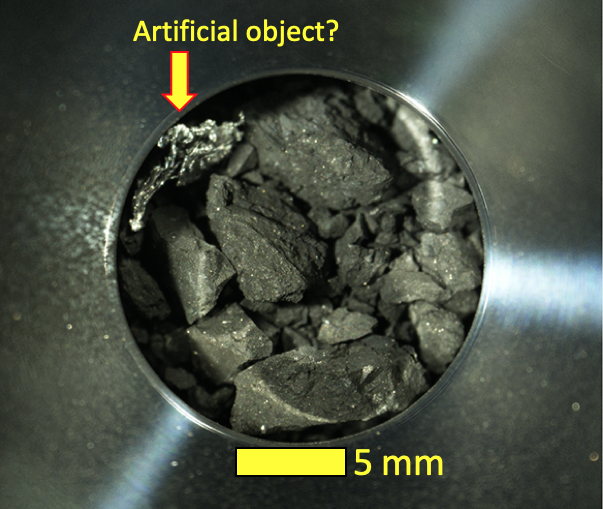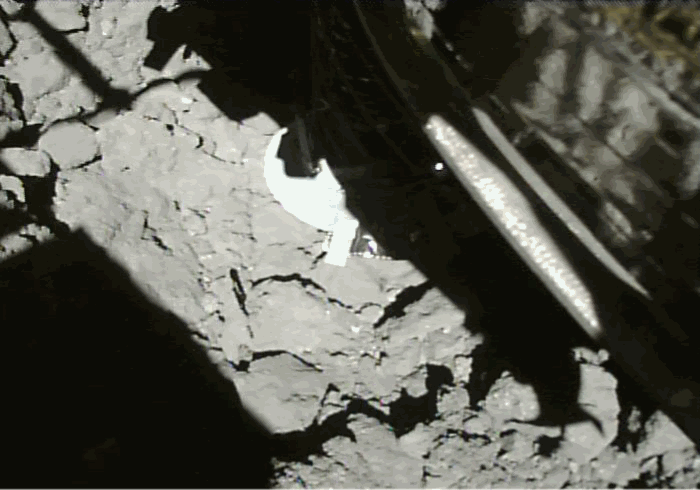UPDATED
Japan’s asteroid probe grabbed a ton of material
on its second attempt

© Provided by BGR asteroid samples
The asteroid probe Hayabusa2, sent by the Japanese space agency JAXA, made two attempts to collect material from the surface of the space rock Ryugu.
As the now-returned samples reveal, the initial attempt gathered fine particles and sandy material, but the second attempt was much more impressive.
JAXA describes the second sample as including rocks as large as nearly half an inch, and they’re very hard.
Japan’s Hayabusa2 asteroid probe mission took a long, long time. Flying to and from the asteroid Ryugu took many months, and the time the spacecraft spent in orbit around the asteroid was lengthy in its own right. The biggest risk for the spacecraft — and one of the most important objectives of the mission — was to bring asteroid samples back to Earth.
It completed that task just a couple of weeks ago, and Japan slowly began to reveal information about the samples that the probe gathered. The first reveal was somewhat underwhelming, revealing some black, charcoal-like dust and small pebbles from the first sample collection attempt. Now, after JAXA showed off its second batch of asteroid sample material we can say with certainty that the mission was an absolutely huge success.
As Komo News reports, the most recent release of images of the asteroid samples offers us a much clearer picture of what Japanese scientists will be working with in the coming months and years. The second sample in particular looks quite promising, with larger chunks of rock that are apparently very hard, according to JAXA.
The differences in the sample material have been attributed to the very different circumstances under which they were collected. The first sample was snatched when Hayabusa2 made a brief touchdown on the asteroid, so it was mostly dust and smaller pebbles from the surface. For the second sample, the JAXA team actually used Hayabusa2 to launch a projectile at the asteroid, blowing a hole in the surface so that material could be collected from within the rock.
The fact that the second sample includes rocks both large and small suggests that the bedrock of the asteroid varies in terms of hardness, according to JAXA space materials scientist Tomohiro Usui. The asteroid samples are being studied in a somewhat casual way at the moment, with observations being noted, but the much more in-depth studies into the material and what the rocks may contain will happen over the course of many months and perhaps even years.
Meanwhile, the asteroid probe itself isn’t done with its work. after dropping the samples off on Earth, the probe cruised back out into space. It’s headed for another asteroid that JAXA wants to study, but this one will take a bit longer to reach. The journey to the asteroid will take 11 years, so we won’t be hearing much about that for some time.
Feast your eyes on the space rocks
Japan’s Hayabusa 2 mission harvested
from asteroid Ryugu
Devin Coldewey@techcrunch / •December 28, 2020

Image Credits: JAXA
Japan’s ambitious second asteroid return mission, Hayabusa 2, has collected a wealth of material from its destination, Ryugu, which astronomers and other interested parties are almost certainly champing at the bit to play with. Though they may look like ordinary bits of charcoal, they’re genuine asteroid surface material — and a little something shiny, too.
Hayabusa 2 was launched in 2014 and arrived at the asteroid named Ryugu in 2018, at which point it deployed a couple landers to test surface conditions. It touched down itself in the next year, blasting the surface with a space gun so that it could collect not just the surface gravel but what might lie beneath it. After a long trip home it reentered the atmosphere on December 5 and was collected in the Australian desert.
Although everything worked perfectly, the team could never really be sure they would truly get the samples they hoped for until they opened the sample collection containers in a sealed room back at headquarters. The materials inside have been teased in a few tweets, but today JAXA posted all of the public images along with some new explanations and discoveries.
For one thing, the “sample catcher” itself had grains of sediment from Ryugu. Perhaps this material, exposed to different conditions than that of the containers, will prove different when analyzed.

Image Credits: JAXA
For another, sample container C appears to have an “artificial object” in it! But don’t get excited — as the team writes on their blog, “the origin is under investigation, but a probable source is aluminium scraped off the spacecraft sampler horn as the projectile was fired to stir up material during touchdown.”
In other words, it’s probably a bit of the probe that came off during the not-so-gentle process of shooting the asteroid and crashing into it.

Image Credits: JAXA
But the most important bit is all the rocks collected as planned. As you can see by the scale bar, these are little more than pebbles, but they’re large enough to show evidence of all kinds of processes leading to their particular shape and makeup. There’s also plenty of smaller-scale dirt and dust from below the surface that scientists hope could show signs of organic materials and water, the building blocks of life as we know it.
The success of the mission is worth celebrating, and the team has only just begun studying the materials brought back from Ryugu — so we can expect more information soon as they perform the painstaking work of analysis on these priceless samples. The Hayabusa 2 Twitter account is probably the best way to stay up to date day to day.
Devin Coldewey@techcrunch / •December 28, 2020

Image Credits: JAXA
Japan’s ambitious second asteroid return mission, Hayabusa 2, has collected a wealth of material from its destination, Ryugu, which astronomers and other interested parties are almost certainly champing at the bit to play with. Though they may look like ordinary bits of charcoal, they’re genuine asteroid surface material — and a little something shiny, too.
Hayabusa 2 was launched in 2014 and arrived at the asteroid named Ryugu in 2018, at which point it deployed a couple landers to test surface conditions. It touched down itself in the next year, blasting the surface with a space gun so that it could collect not just the surface gravel but what might lie beneath it. After a long trip home it reentered the atmosphere on December 5 and was collected in the Australian desert.
Although everything worked perfectly, the team could never really be sure they would truly get the samples they hoped for until they opened the sample collection containers in a sealed room back at headquarters. The materials inside have been teased in a few tweets, but today JAXA posted all of the public images along with some new explanations and discoveries.
For one thing, the “sample catcher” itself had grains of sediment from Ryugu. Perhaps this material, exposed to different conditions than that of the containers, will prove different when analyzed.

Image Credits: JAXA
For another, sample container C appears to have an “artificial object” in it! But don’t get excited — as the team writes on their blog, “the origin is under investigation, but a probable source is aluminium scraped off the spacecraft sampler horn as the projectile was fired to stir up material during touchdown.”
In other words, it’s probably a bit of the probe that came off during the not-so-gentle process of shooting the asteroid and crashing into it.

Image Credits: JAXA
But the most important bit is all the rocks collected as planned. As you can see by the scale bar, these are little more than pebbles, but they’re large enough to show evidence of all kinds of processes leading to their particular shape and makeup. There’s also plenty of smaller-scale dirt and dust from below the surface that scientists hope could show signs of organic materials and water, the building blocks of life as we know it.
The success of the mission is worth celebrating, and the team has only just begun studying the materials brought back from Ryugu — so we can expect more information soon as they perform the painstaking work of analysis on these priceless samples. The Hayabusa 2 Twitter account is probably the best way to stay up to date day to day.
No comments:
Post a Comment